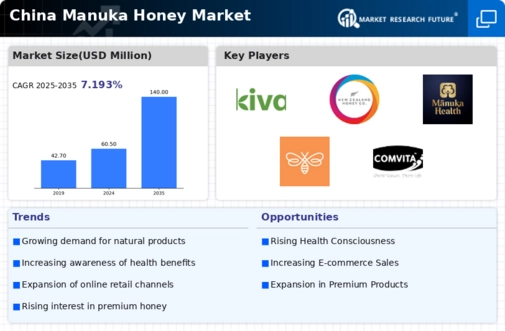The manuka honey market exhibits a dynamic competitive landscape, characterized by a blend of established players and emerging brands. Key growth drivers include increasing consumer awareness regarding health benefits, rising demand for natural products, and the expansion of e-commerce platforms. Companies such as Comvita (NZ), Manuka Health (NZ), and Wedderspoon (US) are at the forefront, each adopting distinct strategies to enhance their market presence. Comvita (NZ) focuses on innovation in product development, particularly in enhancing the potency and purity of its offerings, while Manuka Health (NZ) emphasizes regional expansion, particularly in Asia, to tap into the growing health-conscious consumer base. Wedderspoon (US) leverages digital transformation to enhance customer engagement and streamline its supply chain, thereby shaping a competitive environment that is increasingly reliant on technological advancements.
The business tactics employed by these companies reflect a concerted effort to optimize operations and adapt to market demands. Localizing manufacturing has become a prevalent strategy, allowing companies to reduce costs and improve supply chain efficiency. The market structure appears moderately fragmented, with a mix of large-scale producers and niche players. This fragmentation enables a diverse range of products, catering to varying consumer preferences, while the collective influence of key players drives innovation and quality standards across the sector.
In October 2025, Comvita (NZ) announced a partnership with a leading Chinese e-commerce platform to enhance its distribution capabilities in the region. This strategic move is likely to bolster Comvita's market share in China, capitalizing on the growing trend of online shopping among health-conscious consumers. By leveraging the e-commerce platform's extensive reach, Comvita aims to increase brand visibility and accessibility, thereby positioning itself as a leader in the manuka honey segment.
In September 2025, Manuka Health (NZ) launched a new line of organic manuka honey products, targeting the premium segment of the market. This initiative reflects a strategic focus on sustainability and organic certification, which resonates with the increasing consumer preference for environmentally friendly products. The introduction of this product line not only diversifies Manuka Health's offerings but also strengthens its brand image as a provider of high-quality, ethically sourced honey.
In August 2025, Wedderspoon (US) unveiled a new digital marketing campaign aimed at educating consumers about the health benefits of manuka honey. This campaign, which utilizes social media and influencer partnerships, is designed to enhance brand awareness and drive consumer engagement. By focusing on education, Wedderspoon seeks to differentiate itself in a crowded market, fostering a deeper connection with health-conscious consumers and potentially increasing sales.
As of November 2025, current competitive trends in the manuka honey market are increasingly defined by digitalization, sustainability, and the integration of advanced technologies. Strategic alliances among key players are shaping the landscape, facilitating knowledge sharing and resource optimization. Looking ahead, competitive differentiation is likely to evolve, shifting from price-based competition to a focus on innovation, technology, and supply chain reliability. Companies that prioritize these aspects may find themselves better positioned to capture market share and meet the evolving demands of consumers.
















Leave a Comment